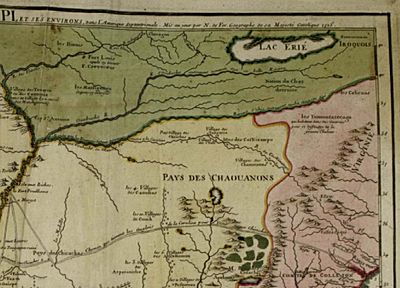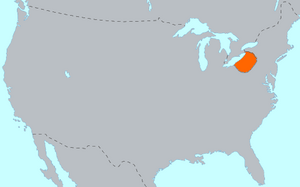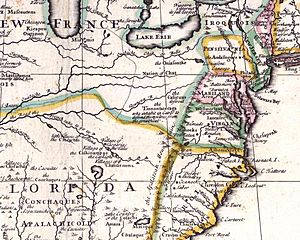Erie people facts for kids
The Erie people were a group of Native Americans who lived a long time ago on the south shore of Lake Erie. They were part of the Iroquoian family of tribes. Before 1658, they lived in what is now western New York, northwestern Pennsylvania, and northern Ohio.
In the mid-1600s, the Erie nation faced a very difficult time. They were involved in a long war with their powerful neighbors, the Iroquois. This war lasted five years. The Erie had helped the Huron people during the Beaver Wars, which were fought to control the fur trade.
The Iroquois burned Erie villages as a warning to others. This destroyed their stored maize (corn) and other foods. Many Erie people lost their lives, and their future was in danger because they had no food for winter. These attacks likely forced them to move away. The Iroquois League was known for adopting people they captured or who became refugees into their own tribes. Most of the Erie who survived are thought to have joined other Iroquoian tribes, especially families of the Seneca, who were the westernmost of the Five Nations. Some Erie families might have also joined the Susquehannock tribe. Over time, these Erie people living among other tribes slowly became part of those cultures and lost their own separate tribal identity.
The Erie were also called the Chat (which means "Cat" in French) or "Long Tail." This name might have come from the raccoon tails they wore on their clothes or from the Eastern Panther, which was important in their beliefs.
Daily Life and Culture
Like other Iroquoian groups, the Erie lived in large long houses where several families shared a home. Their villages were protected by strong wooden fences called palisades. These fences often surrounded their fields where they grew crops.
During the warm seasons, the Erie people were farmers. They grew what they called the "Three Sisters": different kinds of corn, beans, and squash. In winter, they ate the food they had stored from their harvests and animals they caught while hunting.
History of the Erie People
People have lived along the Great Lakes for thousands of years. The historic tribes we know today, like the Erie, started to form around the 1400s and 1500s. The Erie were one of several Iroquoian peoples who shared a similar way of life and spoke an Iroquoian language.
Native American tribes often competed for resources. This competition grew much stronger when European colonists started settling in the area before 1611. The Europeans brought the fur trade, which was very profitable. The demand for beaver and other furs led to over-hunting in some areas. This also led to more violence as tribes fought to control the lands where fur-bearing animals lived. This was the start of the long-running Beaver Wars.
The Erie began to move into lands that other tribes considered their own. Around 1651, they angered their eastern neighbors, the Iroquois League, by taking in refugees from Huron villages that the Iroquois had destroyed. The Erie had fewer firearms than the Iroquois, which put them at a disadvantage in battles.
In 1653, the Erie launched an attack on the western tribes of the Iroquois. They did well in the first year of this five-year war.

Because of this, in 1654, the entire Iroquois Confederacy went to war against the Erie. They also fought against neighboring tribes like the Neutral people along the northern shores of Lake Erie and across the Niagara River, and the Tobacco people who lived between the Erie and Iroquois. Over five years of war, the Iroquois destroyed the Erie, Neutral, and Tobacco groups. The surviving members of these tribes were scattered. By the mid-1650s, the Erie were a broken tribe. The scattered groups survived for a few more decades before being absorbed into the Iroquois, especially the westernmost Seneca nation.
Because the Erie lived further away from the coast, they didn't have much direct contact with early European explorers. Only Dutch fur traders from Fort Orange (now Albany, New York) and Jesuit missionaries in Canada wrote about them in their records. The Jesuits learned more about the Erie during the Beaver Wars, but most of what they knew came from the Huron people, who had suffered greatly before the Erie did. What little we know about the Erie today comes from the oral stories of other Native American tribes, archaeology (studying old objects), and comparing them to other Iroquoian peoples.
Language
The Erie people spoke an Iroquoian language. It is said to have been similar to the Wyandot language.
See also
 In Spanish: Nación del Gato para niños
In Spanish: Nación del Gato para niños



